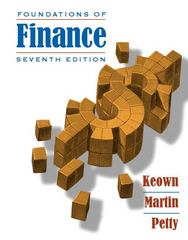You can choose any topic from the list attached that you can write about professionally (except number 5). The course is Financial Mathematics. the project needs to be mainly in mathematics, formulas, proofs, examples in mathematics. Write the project in an organized fashion, by dividing it into sections: 1. Introduction. The introduction must give a clear idea of what is the subject of your project. It should include a description of the problem and the method (or methods) uses to solve it. Any background information should be developed in this part. 2. Main part. This part is basically the body of the project. Statements used must have supporting evidence, examples, proofs or algorithms. You need to provide either a solution or difficulties to solve the problem, or some consequences of the algorithms, and detailed references from the literature or web. 3. Conclusive remarks: Key words: summary, use, comparison of methods or solutions, efficiency, difficulties, weakness, or restrictions of the approach, consequences. 4. Attach computer code, figures, and output of computer code. 5. References. List any books or web page used.
ooo T-Mobile Wi-Fi '6 12:17 AM @ 1 B' 75% CM fl bb-csuohio.blackboardcom '- -g[aue IOI' rms course anu "'lll DE report"! to me unwersrrv. POSSIBLE PROJECTS: Some Project Ideas: (1) Binomial Pricing Option Model: References: (i) Mathematical Interest Theory by Leslie J.F. Vaaler and James Daniel: MAA. 2009 (Section 8.9, p.257-363). (ii) Interest Rate Models by Andrew J.G. Cairns. Princeton University Press, 2004 (p.2937). Or any books, anicles, online information related to the Binomial Pricing Option Model. (2) Using Weighted Averages to Price Options: References: Mathematical Interest Theory by Leslie J.F. Vaaler and James Daniel: MAA. 2009 (Section 8.10, p.368-375), or any books or articles online information. (3) Models for Risk Free Rate of Interest: References: Interest Rate Models by Andrew J.G. Cairns, Princeton University Press, 2004 (p.3742), or any books, articles, online information related to the subject. (4) Swaps: References: Mathematical Interest Theory by Leslie J.F. Vaaler and James Daniel; MAA, 2009 (Section 8.1 l, p.275-38l), or any books, articles, online information related to SWAPS. (5) Interest Rate Sensitivity: References: Mathematical Interest Theory by Leslie J.F. Vaaler and James Daniel: MAA. 2009 (Section 9.1- 9.4, p.393-424), or any books, articles, online information related to the Interest Rate Sensitivity. You may start 9.1 and choose any two sub-topics from Duration (9.2), Convexity (9.3) and Immunization (9.4) to study and form your project. (6) Callable Bonds: References: Mathematical Interest Theory by Leslie J.F. Vaaler and James Daniel; MAA. 2009 (Section 6.9, p.28I-285), or any books, articles, online information related to Callable Bonds. (7) Foreign Currency Exchange Rates: References: Mathematics of Investment and Credit, 4lh Edition, by Samuel A. Broverman, Actex Academic series, 2008 (p.477-480). (8) Term Structure of Interest Rates: References: Mathematical Interest Theory by Leslie J.F. Vaaler and James Daniel: MAA. 2009 (Section 8.3, p.327-337), or any books, articles, online information related to the subject. (9) Rates of Returns over One and Multiple periods and Portfolio Return: References: Financial Mathematics for Actuaries by Wai-Sum Chan and Yiu-Kuen Tse; McGraw Hill 201] (Section 4.2-4.4) (10) Capital Budgeting and Project Appraisal: References: Financial Mathematics for Actuaries by Wai-Sum Chan and Yiu-Kuen Tse: McGraw Hill 2011 (Section 4.8) (11) Discretely and Continuously Compounded Yield Curves: References: Financial Mathematics for Actuaries by Wai-Sum Chan and Yiu-Kuen Tse: McGraw Hill 2011 (Section 7.5-7.6) (12) Term Structure Models: References: Financial Mathematics for Actuaries by Wai-Sum Chan and Yiu-Kuen Tse: McGraw Hill 2011 (Section 7.7)l Q (7' (5 = Document1- MicrosoftWord ? EE - 51 X HOME INSERT DESIGN PAGE LAYOUT REFERENCES MAILINGS REVIEW VIEW GRAMMARLY Sign in Fx 1 1 . . N - v zzvtzvza-fl -*1 HFind' ua EE] A A Aa '3' - i- 1- AaBchDd' AaBchDd AaBbQ AaBchE Aa @ SEC Replace B I U ' abs x x2 [53 ' ai? v A v E E E 1 'I Normal " i No Spac... Heading1 Heading 2 Title , Enab'e 2 - 4 ' 4 R' se'ed Grammarly Clipboard Ii Font Ii Paragraph Ii Styles Ii Editing Grammarlx A Ei We can connect for future services at briihot2@gmail.com or Iet's skxge at enock.asuma2 let's work together friend if; Activate Windox 5 Go to PC settings to a tivate Windows. gi PAGE1OF1 17WORDS fi 'o --I-+ 10096







